29.12.2006
K.Sakaev. Creativity at the Superfinal, Rounds 9-11
Rounds 1-3 Rounds 4-5 Rounds 6-8
Round 9
D.Jakovenko – S.Rublevsky [D19]
1.d4 d5 2.c4 c6 3.¤f3 ¤f6 4.¤c3 dxc4 5.a4 Ґf5 6.e3 e6 7.Ґxc4 Ґb4 8.0-0 ¤bd7 9.Јe2 Ґg6 10.e4 0-0 11.Ґd3 Ґh5 12.e5 ¤d5 13.¤xd5 cxd5 14.Јe3 Ґg6 15.¤g5 ¦e8 16.f4 Ґxd3 17.Јxd3 f5 18.Ґe3 ¤f8 19.ўh1 Ґe7!N Weaker is 19...¦c8 on account of 20.g4! and White gets an attack, Topalov – Kramnik, Elista (m/2) 2006. Of course the member of Kramnik`s team Sergey Rublevsky is familiar with the subtleties of the variation. If Black drives the knight away first he has no problems.
20.¤f3 ¦c8 21.h3 Јc7 22.¦fc1 Јd7 23.¦g1 Јc7 24.¦gc1 Јd7 25.Јb3 1/2-1/2
Evgeny Tomashevsky – Evgeny Alekseev [A30]
1.¤f3 c5 2.c4 ¤c6 3.d4 cxd4 4.¤xd4 e6 5.g3 Јb6 6.¤b3 ¤e5 7.e4 ¤f6 8.Јe2 Ґb4+
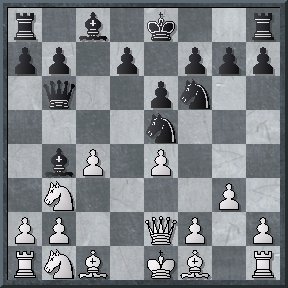
9.Ґd2 Except for the fact that the dark-squared bishop exchange is favourable for Black in itself, the white knights take inadequate positions. A principled continuation is 9.¤c3 allowing the pawn doubling but preserving the important dark-squared bishop.
9...Ґxd2+ An interesting position would arise after 9...a5!? 10.¤c3 (if 10.f4 , then 10...¤c6 11.e5 a4!) 10...a4 11.¤b5 Ґe7 12.¤3d4 Ґc5 13.Ґc3
10.¤1xd2 d6 11.f4 An alternative is 11.Ґg2 , to which interesting and principled is 11...a5! 12.f4 ¤c6 13.c5 (very acute and risky is 13.e5 , burning all the bridges 13...dxe5 14.fxe5 ¤d7 15.c5 ¤xc5 16.¤c4 Јb4+ 17.¤bd2 0-0 (also possible is a crazy line 17...¤d4 18.a3 Јa4 19.¤d6+ ўd8 (inferior is 19...ўd7 20.Јc4 ¤c2+ 21.ўe2 Јxc4+ 22.¤2xc4 ¤xa1 23.¤b6+ ўe7 24.¦xa1 Ґd7 25.¤xa8 ¦xa8 26.¦c1 –and White maintains pressure.) 20.Јh5 ¤c2+ 21.ўe2 Јd4 22.¦hd1 Јd3+ 23.ўf2 Јd4+ 24.ўe2 Јd3+ with a draw by perpetual.) 18.0-0 with compensation for a pawn.) 13...dxc5 14.e5 ¤d5 15.Јf2 , with complex play.
11...¤c6
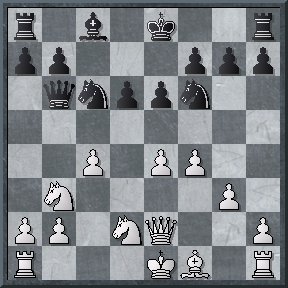
12.0-0-0?! White isn`t properly prepared to a play on opposite flanks as his knights are too poorly placed.
12...0-0 13.ўb1 e5! The dark-squared strategy is just fine.
14.f5 a5 15.g4?! This allows Black to exploit the bad position of the white knights immediately. Better was 15.¤f3 a4 16.¤c1.
15...a4 16.¤c1

16...¤d4 Evgeny is thinking strategically and for that reason he misses a nice tactical opportunity 16...a3! 17.b3 ¤b4 which would have yield him a clear advantage. White has no defence against two primitive threats Јb6-d4 и ¤f6xg4 at the same time while active play leads to approximately following consequences: 18.¤f3 ¤xg4 19.¦g1 ¤e3 20.¦d2
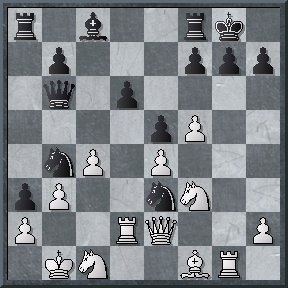
20...d5! As it often happens a hit at the most strengthened point turns out to be fatal: 21.cxd5 (or 21.f6 g6 22.cxd5 ¤exd5 23.exd5 Ґf5+ 24.ўa1 ¦ac8 25.Јe1 e4) 21...¤bxd5 22.exd5 Ґxf5+ 23.¦d3 ¦ac8 24.Ґh3 Ґxd3+ 25.Јxd3 ¦c2 winning.]
17.Јg2 Јc6 To play along the dark squares was stronger 17...a3! 18.b3 Јa5! with ideas Јa5-c3 and b7-b5. It`s important that White has no 19.¤e2 in view of 19...¤xe2 20.Јxe2 Јc3 21.¤f3 ¤xe4! 22.¦d3 b5!
18.¤e2 ¤xe2 19.Ґxe2 ¤d7 20.¦c1 If 20.g5 ¤c5 when White will be forced to waste one more tempo defending against Ґc8xf5, to which Black would have replied with b7-b6 followed by Ґc8-b7 or Ґc8-a6 and b6-b5.
20...b6 21.¦c3 ¤c5
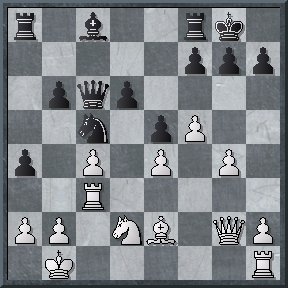
22.¦h3? Correct is the generally reinforcing 22.¦e1 and if 22...Ґb7 (interesting is also 22...Ґa6!? with an idea to carry out b6-b5.) then 23.Ґf1 with a complex play.
22...Ґb7 23.Ґf3? The ending after 23.¦e1 Јxe4+ (bad is 23...¤xe4? 24.Ґf3 ¤xd2+ 25.Јxd2 Јc7 26.Ґxb7 Јxb7 27.f6 and White wins.) 24.¤xe4 Ґxe4+ 25.Јxe4 ¤xe4 26.¦e3 ¤c5 27.¦d1 ¦fd8 is unpromising even though White has drawing chances. It was better to admit the error on the previous move by playing 23.¦e3.
23...¤d3 24.g5 24.Јf1 doesn`t lose on the spot although after 24...¤f4 25.¦g3 ¦fc8 Black threatens with b6-b5 and White has got nothing to protect his queenside with.
24...Јc5 Now apart from the numerous knight forks Black is threatening to checkmate on b2 in the near future.
25.Јg1 ¤f2 26.¦g3 Јd4 27.Јc1 ¤xh1 28.Ґxh1 ¦fc8 29.Јc3 Јxc3 30.¦xc3 Ґa6 31.Ґf3 b5 32.Ґe2 bxc4 33.Ґxc4 ўf8 34.ўc2 ўe7 35.ўd3 ¦c5 36.ўe3 Ґxc4 37.¤xc4 ¦ac8 38.b3 axb3 39.axb3 d5 0-1
Peter Svidler – Evgeny najer [B90]
In the opening Peter Svidler realized a typical queen sac and obtained an excellent play along the light squares. It`s strange that on moves 20 and 21 he didn`t take the d-file by ¤d2-e4. Weakening the white king`s shield by 21...Ґxa3 and regaining the exchange by 22...Ґxd3 Evgeny Najer got better chances in a complicated position. But Evgeny was lacking energy all the way through the tournament and he lacked it in this game as well. Peter Svidler should be pleased with this draw.
1.e4 c5 2.¤f3 d6 3.d4 cxd4 4.¤xd4 ¤f6 5.¤c3 a6 6.Ґe3 e5 7.¤b3 Ґe7 8.f3 Ґe6 9.Јd2 0-0 10.0-0-0 a5 11.Ґb5 ¤a6 12.ўb1 ¤c7 13.Ґb6 Јb8 14.Ґa4 d5 15.Ґxc7 Јxc7 16.exd5 ¦fd8 [16...¦ad8 17.dxe6 ¦xd2 18.exf7+ ўxf7 19.¦xd2 ¦d8]
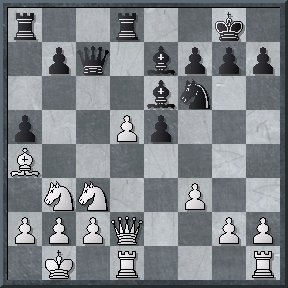
17.dxe6! ¦xd2 18.exf7+ ўxf7 19.¤xd2 ¦d8 20.a3?! [20.¤de4] 20...ўg6 21.Ґb5?! [21.¤de4] 21...Ґxa3 22.Ґd3+ ¦xd3 23.cxd3 Ґb4 24.¤de4 Јd7 25.¦hf1 Ґxc3 26.¤xc3 b5 27.¦fe1 b4 28.¤e4 Јd4 29.¤g3 a4 30.¤e2 Јd6 31.d4 a3 32.g3 ўh6 33.dxe5 Јxe5 34.¤d4 Јa5 35.¦e3 axb2 1/2-1/2
Denis Khismatullin – Ildar Khairullin [A23]
Denis Khismatullin executed a remarkable positional pawn sacrifice 16.Ґd4! obtaining excellent compensation. In spite of some inaccuracies this game is a good creative achievement by Denis. 1.c4 e5 2.¤c3 ¤f6 3.g3 c6 4.¤f3 e4 5.¤d4 d5 6.cxd5 cxd5 7.Ґg2 ¤c6 8.¤xc6 bxc6 9.d3 exd3 10.Јxd3 Ґe7 11.0-0 0-0 12.Ґe3 ¦e8 13.¦ac1 a5 14.Јc2 Ґa6 15.¦fd1 Ґb4
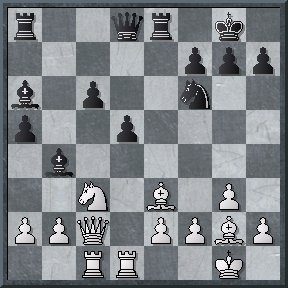
16.Ґd4! Ґxc3 17.Јxc3 Ґxe2 18.¦e1 Ґb5 19.¦xe8+ ¤xe8 20.¦e1 Јd7 21.h4 f6 22.ўh2 [strong was 22.Јc5! , when badis 22...¤d6 due to 23.Ґxd5+] 22...¤d6 23.Ґh3 f5 24.¦e5 a4 25.Јe1 ¦e8 26.Јe3 ¦xe5 27.Јxe5 Ґd3 28.Ґc5 ¤e8 29.Јe3 Ґc2 30.Јc3 Ґd1
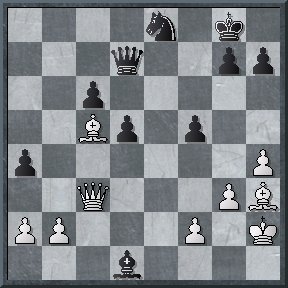
31.Јd4 White misses a possibility to box the bishop by 31.f3! and Black is forced to give the pawn back: 31...d4 (bad is31...Јe6 32.Јd3 Јe1 33.Ґxf5 ¤f6 34.Јa6) 32.Јe1 Ґc2 33.Ґxd4
31...Ґc2 32.Јd2 Ґb1 33.a3 Јe6 34.Јd1 Јe4 35.Ґg2 Јc4 36.Ґb4 Ґe4 37.f3 c5?? 38.Јxa4+- ўf8 39.fxe4 cxb4 40.exd5 f4 41.Јxb4+ Јxb4 42.axb4 fxg3+ 43.ўxg3 ¤d6 44.ўf4 ўe7 45.Ґf1 ¤f7 46.b5 ўd6 47.b6 g6 48.Ґd3 ¤e5 49.b7 ¤xd3+ 50.ўe3 ўc7 51.ўxd3 ўxb7 52.b4 ўb6 53.ўe4 h6 54.ўe5 g5 55.hxg5 hxg5 56.d6 g4 57.ўe4 1-0
Ernesto Inarkiev – Ian Nepomniachtchi [C11]
The fight didn`t start in this game. Right after the opening Black made a serious mistake 15...b4? after which he had no real chances as the white attack unfolded itself.
1.e4 e6 2.d4 d5 3.¤c3 ¤f6 4.e5 ¤fd7 5.f4 c5 6.¤f3 ¤c6 7.Ґe3 cxd4 8.¤xd4 Ґc5 9.Јd2 0-0 10.0-0-0 a6 11.ўb1 ¤xd4 12.Ґxd4 b5 13.Јe3 Ґxd4 14.¦xd4 Јe7 15.Ґd3 b4?
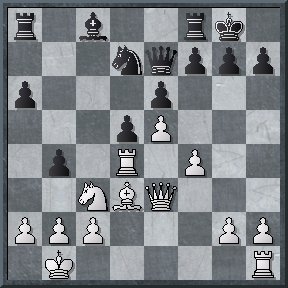
16.¤e4! a5 17.¤d6 f5 18.g4 fxg4 19.Ґe2 ¤c5 20.Ґxg4 ¤b7 21.¤xb7 Ґxb7 22.¦g1 ¦f7 23.Јh3 ¦e8 24.f5 Јc5 25.¦dd1 ¦c7 26.f6 Јxc2+ 27.ўa1 Ґc8 28.Ґh5 ¦d8 29.Јh4 ¦f8 30.f7+ ¦fxf7 31.Ґxf7+ ўxf7 32.Јg5 h6 33.Јd8 Ґa6 34.¦xg7+ ўxg7 35.¦g1+ 1-0
Nikita Vitiugov – Sergey Grigoriants [E48]
Nikita Vitiugov was conducting the game very well taking the initiative after 17.¤h5!. Later on the mistaken moves 22 and 23 deprived him first of his advantage and then of equality. Few moves lafter Sergey Grigoriants amnestied him dropping Black`s edge by 29...¦c2?!
1.d4 ¤f6 2.c4 e6 3.¤c3 Ґb4 4.e3 0-0 5.Ґd3 c5 6.¤ge2 d5 7.cxd5 cxd4 8.exd4 ¤xd5 9.0-0 ¤c6 10.a3 Ґe7 11.Ґc2 ¦e8 12.Јd3 g6 13.Јf3 ¤xc3 14.bxc3 Ґd7 15.¦d1 ¤a5 16.¤f4 Ґd6
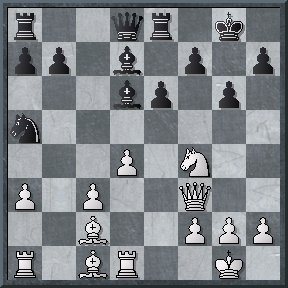
17.¤h5! f5 [17...gxh5? loses to 18.Ґxh7+] 18.Ґf4 Ґxf4 [18...Ґe7 is impossible due to 19.Ґxf5!] 19.¤xf4 ¦c8 20.Јg3 Јc7 21.¦d3 Ґb5 22.¦f3?! Correctis22.¦e3 ¤c4 23.¦ee1! (but not 23.¦xe6 ¦xe6 24.¤xe6 Јxg3 25.hxg3 ¤d6 26.a4 Ґe8 27.¦a3 ¤c4 28.¦a2 ¤d6 with equality) 23...e5 24.dxe5 (interesting though risky is 24.¤xg6 hxg6 25.Ґxf5) 24...¦xe5 25.Ґb3 retaining the initiative.
22...¤c4 23.Ґb3? [23.Ґd3 ¤d6 (dubious is 23...e5?! 24.¤xg6! hxg6 25.Ґxf5) 24.Ґc2 forcing the repetition (the line 24.¤h5 ¦e7 25.¤f6+ ўf7 26.¤xh7 Јxc3 27.¤g5+ ўg8 28.¦f1 Јxd4 is most likely dangerous for White
23...¤d2 24.Ґxe6+ ¦xe6 25.¤xe6 ¤xf3+ 26.Јxf3 Јxc3 27.Јd1 Ґa4 28.Јe1 Јxe1+ 29.¦xe1 ¦c2?! [29...¦c3 gave good winning chances] 30.h4 ¦d2 31.¦e5 b6 32.h5 Ґb3 33.h6 Ґxe6 34.¦xe6 ¦d1+ 35.ўh2 ¦xd4 36.¦e7 ¦h4+ 37.ўg3 ¦xh6 38.¦xa7 g5 39.a4 ¦e6 40.a5 bxa5 41.¦xa5 ¦f6 42.f4 h6 43.fxg5 hxg5 44.ўf3 ўg7 45.g4 ўg6 46.gxf5+ ¦xf5+ 47.¦xf5 ўxf5 1/2-1/2
Round 10
Sergey Grigoriants – Evgeny Alekseev [E32]
1.d4 ¤f6 2.c4 e6 3.¤c3 Ґb4 4.Јc2 0-0 5.a3 Ґxc3+ 6.Јxc3 d6 7.f3 c5 8.dxc5 dxc5 9.¤h3 ¤c6 10.¤f2 e5 11.e3 Ґf5 The pawns are aligned along the dark squares while the pieces are developed on active positions. To watch Black`s play is pure pleasure!
12.Ґe2 An attempt to gain space fails – 12.b4 Јe7 13.b5 ¤d4
12...a5 13.b3 Or else Black will play a5-a4
13...Јe7 14.Ґd1?! Of course a5-a4 is annoying but not to an extent that White should withdraw the pieces. Preferable is 14.0-0 a4 15.Ґb2 with a roughly equal position.
14...¦fd8 15.Ґd2 15.0-0 is still more natural to which Black apart from 15...a4 has the interesting move 15...¦d6!? with an idea to simply grab the d-file.
15...¤d7 Evgeny has tuned himself to the pawn confrontation on the queenside which Sergey Grigoriants is so much afraid of. 15...¦d6!? looks more combative followed by ¦ad8 with prospects of kingside play (that could be started with h7-h5-h4 etc.). But I have to admit that the game continuation is more reliable from strategic standpoint.
16.0-0 a4 17.b4 ¤b6 18.Ґe1 Ґe6 19.Ґe2
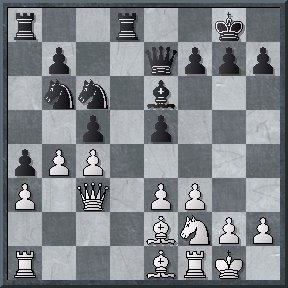
19...¦dc8! It`s desirable to cut off then knight. 19...f5 looks more natural: 20.¤d3 cxb4 (somewhat inferior is 20...Ґxc4 21.bxc5 e4 22.cxb6 Ґxd3 23.Ґxd3 exd3 24.¦d1 Јxe3+ 25.Ґf2 Јe5 26.¦xd3 Јxc3 27.¦xc3 ¦d2 with a possible draw) 21.¤xb4 ¤a5 22.Јxe5 (22.c5 ¤bc4 23.c6 ¦ac8! (a more risky 23...b5 is scarcely justified) 24.cxb7 ¤xb7 and Black keeps on pressing) 22...¤axc4 23.Ґxc4 (23.Ґh4 ¤xe5 24.Ґxe7 ¦d2 25.¦f2 ¦c8) 23...¤xc4 24.Ґh4 (bad is 24.Јf4 g5!) 24...Јd6 25.Јxd6 ¦xd6 and the ending is slightly better for Black. It is very likely that the way Evgeny chose is even stronger.
20.¤e4 [in the line 20.bxc5 Јxc5 21.¤e4 Јe7 22.c5 ¤d5 Black will undermine the c5 pawn by b7-b6, retaining a small edge.] 20...cxb4 21.axb4 f5 22.¤g3?! This is very passive though after the best 22.¤c5 Ґf7 the knight on c5 is somewhat hanging and Black`s chances are better.

22...f4! 23.exf4 ¤d4 24.fxe5?! Now White`s position is completely bad although after the only move 24.c5 ¤d5 25.Јb2 ¤xf4 26.Ґd1 Black has a clear advantage.
24...¤xe2+ 25.¤xe2 Ґxc4 26.Јe3 ¤d5 27.Јe4 ¤xb4 White`s counterplay on the kingside couldn`t even arise as the black passers a and b are marching very fast.
28.ўh1 ¤d3! 29.Ґc3 b5 30.¤g3 ¤c5 31.Јg4 Јe6 32.¤f5 g6 33.¤h6+ ўg7 34.Јh4 Ґxf1 35.¦xf1 ¤b3 36.Ґe1 a3 37.f4 a2 38.f5 gxf5 39.¤xf5+ ўh8 A very good victory by Evgeny Alekseev. 0-1
Nikita Vitiugov – Dmitry Jakovenko [E56]
An approximately equal position after the opening hadn`t presage anything but a boring draw. However Nikita Vitiugov played very poorly allowing Dmitry Jakovenko to score additional half a point which was so important to him.
1.d4 ¤f6 2.c4 e6 3.¤c3 Ґb4 4.e3 0-0 5.Ґd3 c5 6.¤f3 d5 7.0-0 ¤c6 8.cxd5 exd5 9.dxc5 Ґxc5 10.b3 Ґg4 11.Ґb2 a6 12.h3 Ґh5 13.Ґe2 ¦c8 14.¦c1 Ґa7 15.¤h4 Ґg6 16.¤xg6 hxg6 17.Ґf3 d4 18.exd4 Ґxd4 19.Јd2 ¦c7 20.¦cd1 ¦d7 21.Ґxc6 21.¤a4 could lead to a forced draw after 21…b5 22.Ґxc6 Ґxf2+ 23.Јxf2 ¦xd1 24.¤b6 ¦xf1+ 25.ўxf1 Јd3+ 26.Јe2 Јb1+ 27.ўf2 Јf5+ 28.Ґf3 Јc5+ 29.Јe3 Јc2+ 30.Јe2 Јc5+
21...bxc6 22.Јc2 c5 23.¤a4 ¦d5 24.Ґa3 The unsound sideways movement. The central 24.¦fe1 is more solid.
24...¦g5 25.Ґc1 ¦h5 26.Ґe3 Јd6 27.Ґxd4 Once again why not to consolidate the position by 27.¦fe1 defending against ¤f6-g4. If 27...¦d5 , then 28.¤b2 followed by ¤c4 equalizing.
27...cxd4 28.Јd3 ¦d8 29.¦fe1 ¦d5 30.¤b2 ¤h5 31.¤c4 Јf6 32.Јe4? [32.g3 would allow to hold] 32...¤f4 33.¤e5 d3 34.¤f3 ¦5d6 35.ўh1 d2 36.¦f1 ¦d5 37.h4 ¤e6 38.Јe3 Јf4 39.Јxf4 ¤xf4 40.¤g1 ¦d3 41.g3 ¤d5 42.¤e2 ¦e8 43.¤f4 ¤xf4 44.gxf4 ¦e4 45.ўg2 ¦xf4 46.¦h1 ўh7 47.ўf1 ¦e4 48.¦g1 ¦d6 49.f3 ¦xh4 0-1
Sergey Rublevsky – Peter Svidler [B86]
After the opening Peter Svidler`s position seemed to be dangerous but he managed to get off lightly. Moreover on moves 26 and 27 Sergey Rublevsky made a couple of barely noticeable mistakes (26.ўf2, 27.ўg3), and the minor pieces ending was the most probably winning for Black. Nevertheless Peter didn`t use all his chances and the game was drawn.
1.e4 c5 2.¤f3 d6 3.d4 cxd4 4.¤xd4 ¤f6 5.¤c3 a6 6.Ґc4 e6 7.Ґb3 ¤bd7 8.Ґg5 Јa5 9.Ґxf6 ¤xf6 10.0-0 ¤d7 11.f4 ¤c5 12.f5 Ґd7 13.fxe6 fxe6 14.Јh5+ g6 15.Јf3 0-0-0 16.Јf6 ¤xb3 17.Јxh8 ¤xa1 18.¦xf8 ¦xf8 Bad is 18...e5 recommended by theory because of 19.b4 Јb6 20.ўh1 ¦xf8 21.Јxf8+ Јd8 22.Јxd6 Јc7 23.Јf8+ Јd8 24.Јc5+ Јc7 25.¤f3 ¤xc2 26.¤xe5
19.Јxf8+ ўc7 20.ўf1 Јb6 21.Јg7 ўb8 22.¤ce2 If he wished to White could make a draw: 22.Јxd7 Јxd4 23.Јd8+ ўa7 24.¤b5+ axb5 25.Јa5+
22...Јc7 An equivalent possibility is 22...Ґc8 23.e5 (23.Јxh7 e5 24.¤f3 ¤xc2 25.Јxg6 ¤e3+ 26.ўe1 ўa7! Is risky for White) 23...Јc7 24.Јxc7+ ўxc7 25.c3 dxe5 26.¤f3 ¤c2 with a probable draw.
23.c3 e5 24.¤f3 ¤c2 25.Јxh7 ¤e3+ 26.ўf2 [The most natural though perhaps 26.ўe1 is stronger.] 26...¤d1+ 27.ўg3?! [Most likely here too 27.ўe1 is better ] 27...Ґb5 28.Јxc7+ ўxc7 29.¤c1 ¤xb2 30.¤d2 Ґc6 31.ўg4 ¤d1 32.¤e2 Ґb5 33.c4 ¤e3+ 34.ўg5 ¤xc4 35.¤xc4 Ґxc4 36.¤c3
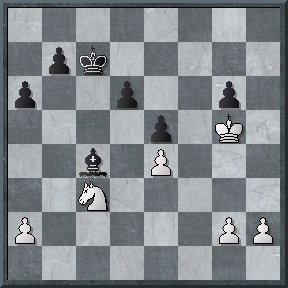
36...b5 [It seems that 36...ўc6 would win: 37.h4 (37.ўxg6 ўc5 38.h4 ўd4 39.h5 ўxc3 40.h6 Ґd3) 37...ўc5 38.g4 (38.ўxg6 ўd4 39.¤d5 ўxe4 40.¤c7 ўf4) 38...ўd4 39.h5 gxh5 40.gxh5 ўxc3 41.h6 Ґg8 42.ўg6 d5 43.ўg7 dxe4 44.ўxg8 e3 45.h7 e2 46.h8Ј e1Ј] 37.a3 a5 38.ўxg6 b4 39.axb4 axb4 40.¤d1 Ґf1 41.¤e3 Ґd3 42.¤d5+ ўd7 43.¤xb4 Ґxe4+ 44.ўf6 Ґxg2 45.¤d3 e4 46.¤e1 Ґh3 47.ўg5 1/2-1/2
Ildar Khairullin – Ernesto inarkiev[C78]
Ildar Khairullin was striving for exchanges from the very beginning probably hoping to make a quick draw. But trading bishops for knights one may only get an inferior position which indeed happened. In the following play Ildar defended well and was close to a draw but in the simple situation erred on move 46 and lost.
1.e4 e5 2.¤f3 ¤c6 3.Ґb5 a6 4.Ґa4 ¤f6 5.0-0 b5 6.Ґb3 Ґc5 7.c3 d6 8.d4 Ґb6 9.Ґg5?! h6 10.Ґxf6 Јxf6 11.Ґd5 Ґd7 12.dxe5 dxe5 13.a4 ¦d8 14.axb5 axb5 15.Ґxc6?! Ґxc6 16.Јe2 g5
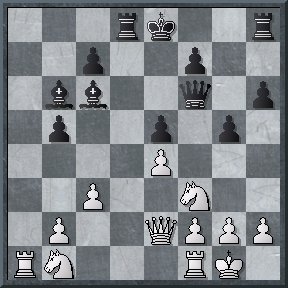
17.b4?! Losing one more tempo. 17...g4 18.¤fd2 h5 19.c4 bxc4 20.¤xc4

20...Ґxe4 21.¦a3 [21.Јxe4? Јxf2+ 22.¦xf2 ¦d1+] 21...Ґxb1 22.¤xb6 cxb6 23.¦xb1 0-0 24.¦e3 ¦fe8 25.f3 ¦d4 26.fxg4 hxg4 27.b5 Јe6 28.h3 f5 29.¦e1 ўg7 30.hxg4 ¦xg4 31.¦xe5 Јxe5 32.Јxe5+ ¦xe5 33.¦xe5 ўf6 34.¦e8 ¦b4 35.ўf2 ўg5 36.¦e6 ¦xb5 37.g3 ¦b2+ 38.ўf3 ¦b3+ 39.ўf2 b5 40.¦b6 ¦b1 41.ўf3 b4 42.ўf2 ўg4 43.¦g6+ ўh5 44.¦f6 ўg5 45.¦b6 ¦b3
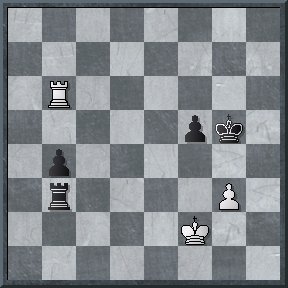
46.ўg2? A draw could be achieved by any means: [46.ўe2 ўg4 47.¦g6+ ўh3 48.ўf2 ¦b2+ 49.ўf3 ўh2 50.g4 fxg4+ 51.¦xg4; also possible is 46.¦b8 ўf6 47.¦b5 ¦b1 48.ўf3 b3 49.ўf2 ўe6 50.ўg2]
46...f4-+ 47.gxf4+ ўxf4 48.ўf2 ¦b2+ 49.ўe1 ўe3 50.ўd1 ўd3 51.ўc1 ўc3 52.¦h6 ўb3 53.¦h3+ ўa2 54.¦h4 ¦b1+ 55.ўd2 b3 56.¦a4+ ўb2 57.¦a8 ¦a1 58.¦b8 ¦a7 59.ўd3 ¦d7+ 60.ўe3 ўc2 61.¦c8+ ўb1 62.¦b8 b2 63.¦b6 ¦a7 64.ўd2 ўa1 0-1
Ian Nepomniachtchi – Evgeny Tomashevsky [C22]
In a tough fight Evgeny Tomashevsky outplayed his younger opponent but before time-control being short of time he missed his advantage. The unexpected knight jump 41.¤e2! made Black continue being a pawn down but Evgeny succeeded in drawing the game.
1.e4 e5 2.d4 exd4 3.Јxd4 ¤c6 4.Јe3 g6 5.¤c3 Ґg7 6.Ґd2 d6 7.0-0-0 ¤f6 8.h4 Ґe6 9.¤h3 Јe7 10.¤f4 h5 11.Ґb5 0-0 12.f3 ¤e5
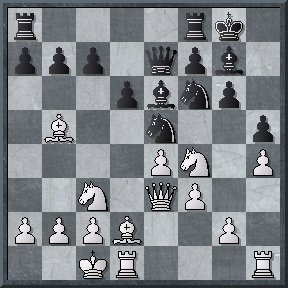
13.g4 hxg4 14.fxg4 [14.h5!?] 14...¤exg4 15.Јg1 ¤h5 16.¤xe6 [16.Ґe2!?] 16...Јxe6 17.Ґe2 ¤gf6 18.¦f1 Јe5 19.¦h3 ¦ae8 20.Ґxh5 ¤xh5 21.¦d3 [21.Јxa7 Јe6 22.¦hf3 Ґxc3 23.Ґxc3 Јxe4] 21...c6 22.Јxa7 b5 23.Јb7 Јc5 24.¦df3 Јc4 25.b3 Јd4 26.a3 Јc5 27.ўd1
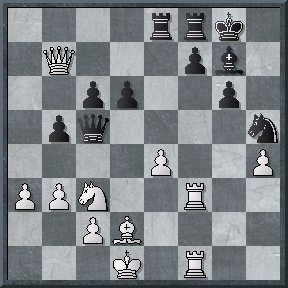
27...f5 [27...¦a8!?] 28.exf5 ¦f7 29.Јa6 ¦xf5 30.¦xf5 gxf5 31.Јa5 ¤g3 32.¦e1 ¦xe1+ 33.Ґxe1 Јd4+ 34.Ґd2 Јg1+ 35.Ґe1 Јd4+ 36.Ґd2
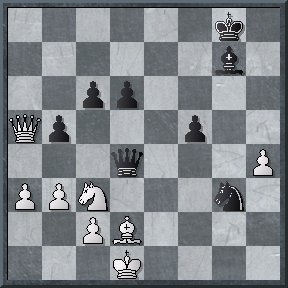
36...¤f1? [36...ўh7! should have led to a win.] 37.Јd8+ ўh7 38.Јg5 ¤xd2 39.Јxf5+ ўg8 40.Јe6+
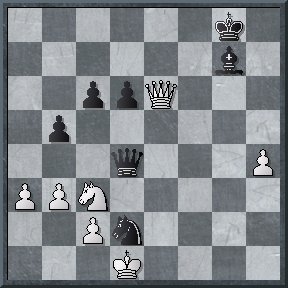
40...ўf8? [40...ўh8 41.Јc8+ ўh7 42.Јf5+ , and a draw by perpetual.] 41.¤e2 Јxh4 42.Јxd6+ ўf7 43.Јd7+ ўf8 44.Јf5+ ўe7 45.ўxd2 Јh6+ 46.¤f4 [Better is46.Јf4 retaining some winning chances.] 46...Јh2+ 47.ўd3 Јg3+ 48.ўe2 Јh2+ 49.ўf3 Јh1+ 50.ўg4 Јg1+ 51.ўh5 Јh2+ 52.¤h3 Ґb2 53.a4 bxa4 54.bxa4 Јe2+ 55.ўg6 Јe6+ 56.Јxe6+ ўxe6 57.¤f4+ ўd6 58.ўf5 Ґc3 59.¤e2 Ґa5 60.¤c1 ўc5 61.¤a2 Ґe1 62.¤c1 Ґa5 63.¤d3+ ўc4 64.¤e5+ ўc3 65.¤xc6 Ґb6 66.ўe4 ўxc2 67.a5 Ґxa5 68.¤xa5 1/2-1/2
Evgeny Najer – Denis Khismatullin [B90]
Once more Evgeny Najer gave a proof of his poor form at this tournament. Unfortunately he made a mistake every time he got an opportunity to do it. This doesn`t detract from Denis Khismatullin`s merits. He gradually tipped the scale to his favour.
1.e4 c5 2.¤f3 d6 3.d4 cxd4 4.¤xd4 ¤f6 5.¤c3 a6 6.f3 e5 7.¤b3 Ґe6 8.Ґe3 ¤bd7 9.Јd2 Ґe7 10.g4 0-0 11.0-0-0 b5 12.g5 ¤h5 13.¤d5 Ґxd5 14.exd5 Јc7 15.ўb1 f5 16.¦g1 [16.gxf6 leads to a better play as well] 16...Ґd8 17.h4 [interesting is a possibility of playing along the c-file by 17.c4!? bxc4 18.¦c1] 17...Јb8 18.f4 [strong was 18.g6! f4 (bad is18...h6 due to 19.Ґxh6) 19.Ґf2 Ґb6 20.gxh7+ ўh8 21.¦g6 , with an advantage in a complex play.]
18...¤xf4 19.Ґxf4 exf4 20.Јxf4 Ґb6 21.¦g3 ¤e5 22.h5 g6 Now Black has a good play.
23.Ґe2 ¦a7 24.¦h3 ¦g7 25.a3 Јd8 26.¦dh1 Јe7 27.c3 gxh5 28.¦xh5 ¤g6 29.Јh2 ¦ff7 30.¤d4?! This move looks ugly 30...Ґxd4 31.cxd4 Јe4+ 32.ўa1 ¦c7 33.¦h6 ¦c2
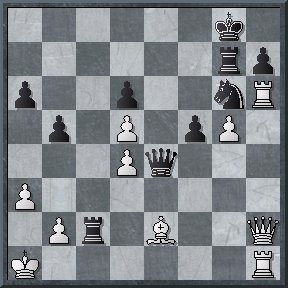
34.¦xh7 [White had a nice draw by 34.¦xg6! hxg6 35.Јh8+ ўf7 36.Ґd3! Јxd3 37.Јd8 Јe4 38.Јf6+ ўg8 39.Јd8+ , but to find such thing in a time scramble is impossible.] 34...¦xe2 35.¦xg7+ ўxg7 36.Јh6+ ўf7 37.Јh7+ ўf8 38.Јh6+ ўe7 39.Јg7+ ўd8 40.¦c1 ¤e7 0-1
11 тур
Dmitry Jakovenko – Sergey Grigoriants [B82]
Dmitry Jakovenko couldn`t deal quite well with the last round emotions and played poorly in the opening. However he offered a draw in time when his opponent Sergey Grigoriants hasn`t yet smelled blood. The final position is more promising for Black.
1.e4 c5 2.¤f3 ¤c6 3.d4 cxd4 4.¤xd4 e6 5.¤c3 d6 6.Ґe3 ¤f6 7.f4 Јc7 8.Јf3 a6 9.0-0-0 Ґd7 10.¦g1 h5 11.h3 h4 12.ўb1 ¦c8
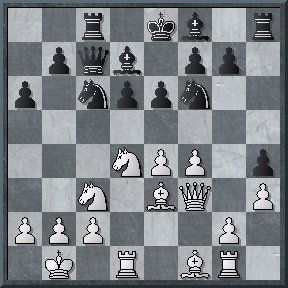
13.f5?! It is better not to allow ¤e5. Very interesting is 13.Ґc4!? with idea 13...¤xd4 14.¦xd4 e5 15.fxe5 dxe5 16.¤d5; The banal 13.Ґd3 also looks better than the text.
13...¤e5 14.Јf2 b5 15.Ґd3 Јb7 16.fxe6 fxe6 17.¦ge1 Ґe7 18.¤f3 [The possible continuation is 18.¤f3 b4 19.¤e2 ¤xd3! (risky is 19...¤xe4 20.Ґxe4 Јxe4 21.¤ed4) 20.cxd3 b3 with Black`s advantage.] 1/2-1/2
Evgeny Alekseev – Ian Nepomniachtchi [B91]
As well as his competitor Dmitry Jakovenko, Evgeny Alekseev couldn`t manage his anxiety and also obtained an inferior position. His opponent, the young star Ian Nepomniachtchi played very hazardously refusing to grab the attacked pawns without visible reasons. The initiative change hands but finally the game ended in a draw.
1.e4 c5 2.¤f3 d6 3.d4 cxd4 4.¤xd4 ¤f6 5.¤c3 a6 6.g3 e5 7.¤b3 Ґe7 8.Ґg2 b5 9.Ґg5 ¤bd7 10.¤d5 ¤xd5 11.Јxd5 ¤b6 12.Ґxe7 ўxe7 13.Јd2 f6 14.0-0 Ґe6 15.c3 ¦c8 16.h4 ¤c4 17.Јe2 Јb6 18.¤c1 b4 19.cxb4
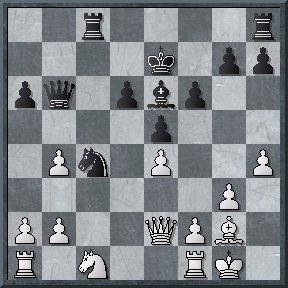
19...h5!? [19...Јxb4 led to approximate equality.] 20.Ґf3 g5 21.hxg5 fxg5 22.¤d3 g4 23.Ґg2 h4 24.gxh4
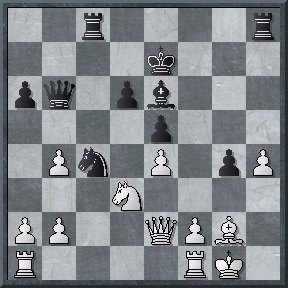
24...g3?! [24...¦xh4 looked quite sound. Black would have an initiative.] 25.b3 ¤a3 26.¦ac1 ¦cg8 27.Јe3 Јxe3 28.fxe3 Ґd7
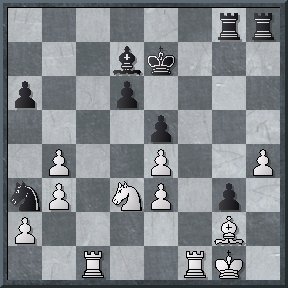
29.¦c7?! At this point White could turn the game in his favour by 29.b5! a5 (bad is 29...Ґxb5 30.¦c7+ ўd8 31.¦a7 Ґxd3 32.¦ff7 ўe8 33.¦fb7) 30.b6
29...¦xh4 30.¦fc1 ¦hh8 31.¦a7 ¤b5 32.¦b7 32.¦xa6 ¦c8 (32...Ґh3 33.Ґxh3 ¦xh3 34.a4 ¦gh8 35.axb5 ¦h1+ 36.ўg2 ¦8h2+ 37.ўf3+-) 33.¦xc8 ¦xc8 34.a4 ¦c3! (Black retains certain counterplay after 34...¦c2 35.Ґf1 ¤c3 as well) 35.Ґf1 ¤c7 36.¦a7 ўd8 37.b5 ¦xb3 , and the white pawns go nowhere in particular.
32...¦b8 33.¦xb8 ¦xb8 34.Ґf3 Ґh3 35.Ґe2 [35.a4! ¤a3 36.¦c7+ with an edge] 35...¦c8 36.¦xc8 Ґxc8 37.ўg2 ¤c3 38.¤c1 ¤xe4 39.Ґf3 ¤c3 40.ўxg3 d5 41.ўf2 ўd6 42.ўe1 d4 43.ўd2 e4 44.Ґh5 ўe5 45.Ґf7 [a draw was achieved simpler after 45.¤e2 ] 45...Ґg4 46.a4 ¤b1+ 47.ўc2 ¤a3+ 48.ўd2 dxe3+ 49.ўxe3 ¤c2+ 50.ўd2 ¤xb4 51.ўc3 a5 52.Ґc4 Ґh5 53.Ґb5 ўd5 54.Ґc4+ ўc5 55.Ґg8 Ґg4 56.Ґf7 ¤c6 57.Ґg6 Ґf3 58.¤a2 ¤e5 59.Ґxe4 Ґxe4 60.b4+ axb4+ 61.¤xb4 ¤d7 62.¤d3+ ўb6 63.ўd4 Ґh1 64.a5+ ўxa5 65.¤e5 ¤f6 66.¤d3 ўb5 67.¤f2 Ґa8 68.¤d3 ўc6 69.¤e5+ ўd6 70.¤c4+ ўe6 71.¤e3 ¤g8 72.¤c4 ¤e7 73.¤e3 Ґf3 74.¤c4 ¤f5+ 75.ўc5 Ґe2 76.¤d2 ўe5 77.¤c4+ ўf4 78.¤d6 ¤g7 79.ўd4 Ґf3 80.¤c4 ¤e6+ 81.ўc3 Ґd5 82.¤b6 Ґb7 83.¤c4 Ґa6 84.¤d2 ўe5 85.¤c4+ ўd5 86.¤b6+ ўc6 87.¤c4 ўc5 88.¤e3 ¤g5 89.¤d1 ¤e4+ 90.ўc2 ўd4 91.ўb3 ¤c5+ 92.ўc2 Ґc4 93.ўd2 ¤e4+ 94.ўe1 Ґe6 95.¤f2 ¤g5 96.ўd2 Ґc4 97.¤d1 ¤f3+ 98.ўc2 Ґe6 99.¤b2 Ґf7 100.¤a4 ¤e1+ 101.ўd2 ¤f3+ 102.ўc2 ¤e5 103.¤c3 Ґg6+ 104.ўb3 ўd3 105.ўb4 Ґe8 106.¤b5 ¤d7 107.¤c7 Ґg6 108.¤e6 ўe3 109.¤c5 ¤b8 1/2-1/2
Peter Svidler – Nikita Vitiugov [B48]
Strange as it may seem Peter Svidler didn`t come out of the opening with White! Or to put it more precise he has come out but with an inferior position. Therefore he shouldn`t be too disappointed with the result of this game as well as Nikita Vitiugov for whom a draw against such a strong opponent is quite a decent outcome especially taking into account his poor performance in this tournament.
1.e4 c5 2.¤f3 e6 3.d4 cxd4 4.¤xd4 ¤c6 5.¤c3 Јc7 6.Ґe3 a6 7.Јd2 ¤f6 8.0-0-0 Ґb4 9.f3 ¤e5 10.¤b3 b5 11.Јe1 Ґe7 12.f4 ¤g6 13.e5 ¤g4 14.Ґd2 An alternative is 14.¤e4 0-0 15.Ґc5
14...Ґb7 15.Ґd3 ¦c8 16.Јe2 In case of 16.¤e4 White was probably afraid of 16...¤6xe5!? 17.fxe5 ¤xe5 18.Јe2 ¤xd3+ 19.Јxd3 Јc4 20.¤f2 Ґxg2 21.¦hg1 Ґf3
16...f5 17.exf6 Giving up the fight for an opening advantage. Most likely White doesn`t have it but 17.h3 or 17.ўb1 led to a more complex play.
17...¤xf6 18.¦hf1 0-0 19.g3 b4 20.¤e4 ¤xe4 21.Ґxe4 a5 If 21...Ґxe4 22.Јxe4 d5 23.Јxe6+ ўh8 , then White could borrow the right idea from Ernesto Inarkiev`s game of this round –24.¤a1!.
22.¤d4 Ґf6 Dangerous for White is another branch 22...Ґxe4!? 23.Јxe4 Јc4 24.b3 Јa6 with idea to meet 25.f5 by 25...a4 but Nikita plays more in a positional style.
23.Ґxb7 Јxb7 24.Ґe3 ¤e7 25.¤b5 ¤f5 26.Ґf2
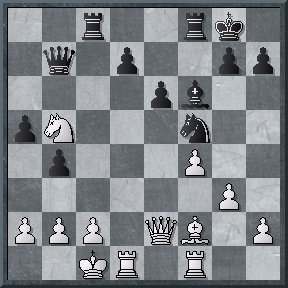
26...¦c6 Very strong was 26...h5! securing the knight`s post. Now an attempt to renew the threat of g3-g4 fails for tactical reasons: 27.h3 Јg2 28.¦g1 ¤xg3 29.Јd2 Јc6 30.Јd3 (30.¤a7 Јc4 31.¤xc8 Јxa2 32.¤e7+ (32.Јd3 Ґxb2+ 33.ўd2 Ґc3+ 34.ўe3 ¤f5+ 35.ўf3 ¦xc8 36.Јxd7 Јc4) 32...Ґxe7 33.Јe3 ¤f5 34.Јb3 Јxb3 35.cxb3 d5 36.ўb1 Ґd6 37.¦c1 Ґxf4 38.¦c6 e5) 30...¤e4 31.Ґd4 Ґxd4 32.¤xd4 Јd5 It means that White would have forced to play 27.ўb1but after the simple 27...a4 Black is attacking.
27.g4 ¦fc8 27...¦b8!? 28.gxf5 (28.¤a7 b3 29.¤xc6 Ґxb2+ 30.ўd2 Јxc6 31.Јd3 bxc2 32.Јxc2 Јd5+ 33.ўe1) 28...Јxb5 29.Јxb5 ¦xb5 30.fxe6 dxe6 31.Ґd4 ўf7
28.¦d2 ¦c4 29.b3 Јxb5 30.bxc4 Јa4 31.Јd3 A draw could be achieved at once by 31.gxf5 Јxa2 32.¦xd7 Јa1+ (32...b3 33.Јxe6+ ўh8 34.ўd2 Јxc2+ 35.ўe3+- is in White`s favour) 33.ўd2 Јc3+
31...Јxa2 32.ўd1 ¤e7 33.Јb3 Јxb3 34.cxb3 d5 35.c5 ўf7 36.¦a2 The final position is a bit more pleasant for Black though a draw is probably unavoidable.
1/2-1/2
Ernesto Inarkiev – Evgeny Najer [B90]
1.e4 c5 2.¤f3 d6 3.d4 cxd4 4.¤xd4 ¤f6 5.¤c3 a6 6.Ґe3 e5 7.¤b3 Ґe7 8.f3 Ґe6 9.Јd2 0-0 10.0-0-0 a5
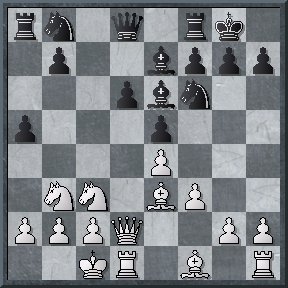
11.a4 Having played 11.Ґb5 in the 9th round Peter Svidler couldn`t obtain a clear advantage, therefore Ernesto Inarkiev chooses another direction.
11...¤c6 12.g4 ¤b4 13.ўb1 ¦c8 White has an edge in case of 13...d5 14.g5 ¤xe4 15.fxe4 d4 16.¤xd4 exd4 17.Ґxd4 Ґg4 (17...Ґxg5 18.Јg2) 18.Ґe2 Ґxg5 19.Јe1 Ґxe2 20.Јxe2
14.h4 d5 15.g5 ¤h5 15...¤d7 16.exd5 Ґf5 17.¤a1 Ґd6 (if 17...Ґc5 then 18.Ґb5 , consolidating the queenside.) 18.Ґh3 Ґxh3 19.¦xh3 ¤c5 20.Јg2 with an advantage.
16.exd5 Ґf5 17.¤a1 ¤g3
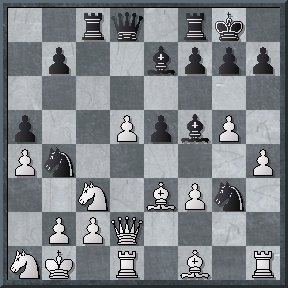
18.Ґh3! Who wants to trade the bishop for the knight?
18...Ґxh3 19.¦xh3 ¤f5 20.f4 Ґd6 [There is no compensation for a pawn after 20...¤xe3 21.Јxe3 exf4 22.Јxf4 Ґd6 23.Јg4 threatening with ¤c3-e4 and with h4-h5 and g5-g6. It should be taken into consideration that the knight isn`t placed badly on a1 as it protects the c2 pawn and is ready to enter the game via b3 at any moment.
21.fxe5 Ґxe5 22.Ґf4 ¦e8 Bad is 22...Ґxc3 23.¦xc3 ¦xc3 24.bxc3 ¤a6 25.Јd3 (also strong is the simple 25.¤b3!? ) 25...Јd7 (25...¤xh4 26.¦h1 ¤g6 27.Јh3 h6 (27...¦e8 28.Јxh7+ ўf8 29.d6) 28.Ґe3) 26.Јb5 (26.¤b3!?) 26...Јxb5+ 27.axb5 ¤c5 28.¤b3 ¤a4 29.¦d3 ¦c8 30.d6 and White wins. If 22...Ґd4 23.¤b3 Јd7 then very strong is 24.h5! creating apart from g5-g6 the threat of h5-h6 which will be topical after the elimination of the black dark-squared bishop.
23.d6?! The premature bodily movement. In the meantime it was better to bring a piece near to the heart of the battle: 23.¤b3! Black has no compensation for a pawn. He is unable to attack anything: 23...Ґxc3 24.¦xc3 Јd7 25.¤c5! ¦xc5 26.¦xc5 Јxa4 27.Јc3 , and Black has only a couple of checks.
23...Јd7 24.Ґxe5 ¦xe5 25.Јf4 ¦ce8 Black inevitably regains the pawn.
26.Јg4 Once again it was better to bring a piece into action by 26.¤b3
26...¦8e6 More precise is 26...¦e1! 27.¦h1 ¦xh1 28.¦xh1 Јc6, and Black is even slightly better.
27.¤b3 ¦xd6 28.¦hh1 g6?! It is either a blunder or an unsound sacrifice. The solid move 28...b6 maintained a rough equality.
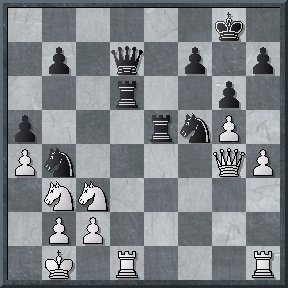
29.¤xa5! ¤d5 30.¤e4?! [30.¤xd5 ¦exd5 31.¦xd5 ¦xd5 32.¤b3 and Black`s compensation for a pawn is insufficient.]
30...¤fe3? 30...¦a6 led to an unclear ending: 31.¤b3 (hazardous is 31.¤c5 Јc7! (31...Јc8 32.¤xa6 ¤de3 33.Јe2 ¦xa5 34.¦d3 ¦xa6 35.¦xe3 ¤xe3 36.Јxe3 ¦xa4 leads to a draw) Suddenly White has problems for example 32.¤ab3 (32.¤xa6 Јxa5; 32.¤axb7 ¦b6) 32...¦c6 , or 32.¤xa6 Јxa5, or 32.¤axb7 ¦b6) 31...Јxa4 32.¤f6+ ¤xf6 33.Јxa4 ¦xa4 34.gxf6. It`s difficult to say whose pawns run faster – White`s on the queenside or Black`s on the kingside.
31.Јxd7 ¦xd7 32.¦d4 Now it`s over.
32...¤c3+ 33.bxc3 ¦xd4 34.cxd4 ¦xa5 35.¦e1 ¤d5 36.c4 ¤c7 37.¤f6+ ўf8 38.¤xh7+ ўg7 39.¦e7 ¤e6 40.d5 ¤c5 41.¤f6 1-0
Evgeny Tomashevsky – Ildar Khairullin [A26]
1.c4 ¤f6 2.¤c3 g6 3.g3 Ґg7 4.Ґg2 0-0 5.¤f3 d6 6.0-0 ¤c6 7.d3 e5 8.¦b1 a5 9.a3 h6 10.b4 axb4 11.axb4 Ґe6 12.b5 ¤e7 13.Ґb2 1/2-1/2
Denis Khismatullin – Sergey Rublevsky [A22]
Sergey Rublevsky knows the resulting pawn structure inside out (true with colours reversed: he usually obtains it in the Sicilian line 1.e4 c5 2.¤f3 ¤c6 3.Ґb5 g6 4.Ґxc4 dxc6 etc.) Regardless of the black pieces he was exerting some pressure through habit. His knight was somewhat stronger than the white dark-squared bishop. Nevertheless his advantage wasn`t significant and by accurate defence Denis Khismatullin achieved a draw.
1.c4 ¤f6 2.¤c3 e5 3.g3 Ґb4 4.Ґg2 0-0 5.¤f3 Ґxc3 6.dxc3 d6 7.0-0 h6 8.¤e1 ¤c6 9.¤c2 Ґd7 10.h3 ¤h7 11.e4 Јc8 12.ўh2 ¤e7 13.¤e3 ўh8 14.b3 a6 15.a4 a5 16.¦a2 f5 17.exf5 ¤xf5 18.f4 exf4 19.¤xf5 ¦xf5 20.Ґxf4 Ґc6 21.g4 ¦f7 22.Ґd5 Ґxd5 23.Јxd5 Јe8 24.¦af2 b6 25.Ґg3 ¦xf2+ 26.¦xf2 ¤f6 27.Јf3 Јe4 28.ўg2 Јxf3+ 29.¦xf3 ўg8 30.¦e3 ўf7 31.Ґh4 g5 32.Ґf2 ¤d7 33.¦f3+ ўg6 34.¦e3 ўf7 35.¦f3+ ўe6 36.¦e3+ ¤e5 37.Ґg3 ¦h8 38.¦e1 h5 39.¦e2 hxg4 40.hxg4 ¦e8 41.¦e1 ¦e7 42.Ґf2 ўd7 43.¦e4 ¤d3 44.¦xe7+ ўxe7 45.Ґe3 ўf6 46.Ґd4+ ўe6 47.Ґe3 ўf6 48.Ґd4+ ¤e5 49.ўg3 c5 50.Ґxe5+ ўxe5 51.ўf3 d5 52.cxd5 ўxd5 53.ўe3 c4 54.b4 ўe5 55.b5 ўd5 1/2-1/2
Dmitry Jakovenko – Evgeny Alekseev [B85]
1.e4 c5 2.¤f3 d6 3.d4 cxd4 4.¤xd4 ¤f6 5.¤c3 a6 6.Ґe3 e6 7.a4 ¤c6 8.Ґe2 Ґe7 9.0-0 0-0 10.f4 Јc7 11.ўh1 Ґd7 The idea behind the chosen move is to put the bishop on c6 after the knight exchange on d4. But it has a drawback: the d7 square is commonly reserved for the knight and Dmitry exploits this. 11...¦e8 is considered to be the main continuation but in this case Black should be prepared to the sharp 12.a5!? ¤xa5 13.e5 which has already been seen in Dmitry Jakovenko`s games.
12.¤b3 b6 13.Ґf3 ¦fe8 14.g4 White`s attack is very dangerous. 14...Ґc8 15.g5 ¤d7 16.Ґg2 Ґf8 17.¦f3 g6 18.¦h3 ¦b8 19.Јe1 Ґg7 20.Јh4 ¤f8 21.¦f1
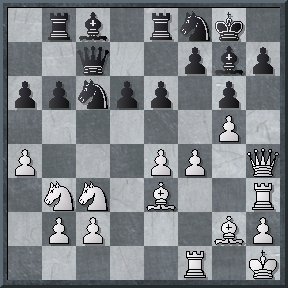
21...¤e7?! This knight shouldn`t have been retreated anywhere. It should be ready to stand on e5 after White carries out f4-f5. At the same time being placed on c6 it makes impossible the dark-squared bishop exchange that favours White. b6-b5 played in one of Sergey Movsesian`s games is stronger and more consistent though Black`s position is all the same very dangerous.
22.Јf2 b5 23.axb5 axb5
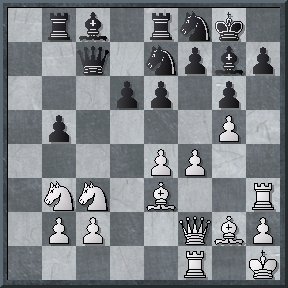
24.Ґa7! Of course it`s useful to lure the rook at an uncomfortable square. 24...¦b7 25.Ґd4 b4 26.Ґxg7 ўxg7 27.¤d1 Јb6 28.¤e3
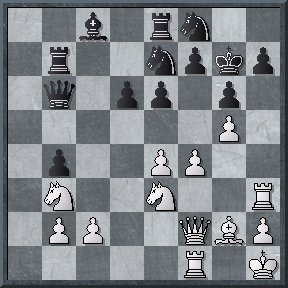
28...h5! A typical method. Black relieves pressure on the h-file but he is left with his problems anyway as after the exchange of the bishops the dark squares are very weak.
29.gxh6+ ўh8
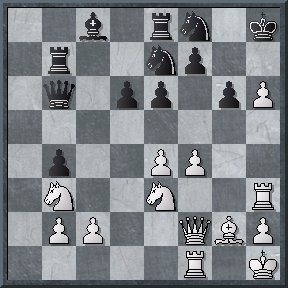
30.h7!? The idea behind this move is to deprive the black knight of the h7 square but White loses a vital tempo. It was possible to obtain a position where White retains an edge without running any risk - 30.¤c4 Јxf2 31.¦xf2 and Black`s pawns d6 and b4 are weak. But Dmitry feared to sell it out too cheap and decided to go on with attack. However White has no decisive continuations e.g. 30.e5 d5 31.Јh4 ¤h7 or 30.Јh4 ¤h7 31.¤g4 (31.f5 exf5 32.exf5 ¤xf5) 31...¦f8 (with idea of f7-f5, worse is 31...¤g8 32.¦d3, falling on d6). 32.¤f6 ¤g8 33.¤xg8 ¦xg8;
30.¦g3!? ¦c7 31.Јd2!? looks to me the most promising. White reserves many ideas – the pawns d6 and b4 are still weal, White is constantly threatening with f4-f5 moreover Black should reckon with h2-h4-h5 which would open his king`s position even more.
30...¤c6 31.f5 exf5 32.Јf4 A relief for Black would be 32.Јh4 Јd8 33.Јxd8 ¤xd8 34.exf5 ¦be7 transposing into a roughly equal ending.
32...¤e6 33.Јh4
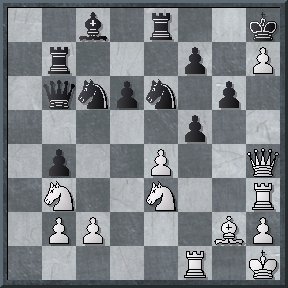
33...f4? 33...¤g7! kept a defensible position even though White`s chances are somewhat better for example 34.exf5 ¦xe3 35.¦xe3 Јxe3 36.Ґxc6 g5 37.Јd4 Јxd4 38.¤xd4 ¦c7 39.Ґe4 ¦e7 40.Ґd3 Ґb7+ 41.ўg1 f6 42.¦a1 with an edge in the ending.
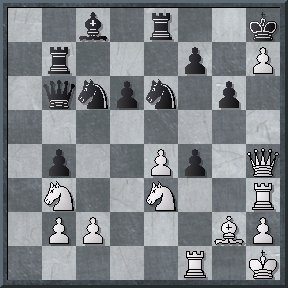
34.¤f5? The accumulated tiredness, the great nervous tension and mutual time scramble begin to tell. The simple 34.¤c4 Јd8 35.¤xd6 g5 36.Јh6 won on the spot.
34...gxf5 35.exf5 ¤g7 36.f6
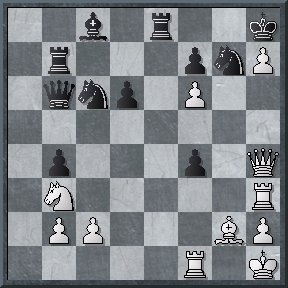
36...¤f5? The most natural but not the strongest. 36...¤e6! with the following transference of another knight to e5 via g6 allowed to repel the attack retaining the extra piece.
37.Јxf4 ¤e5
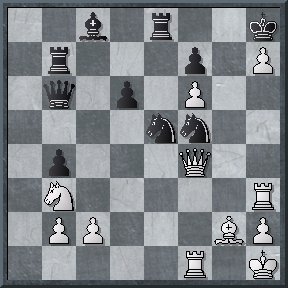
38.¦e1? White misses the obvious 38.Јg5 ¤g6 39.¦hf3! (this move is not that obvious for rapid play: I think both opponents didn`t see it from afar) Black would have had to defend again though after 39...¦c7 40.¦xf5 Јe3 all the fight is ahead and in rapid chess everything could have happened.
38...Јd8 39.¦h5 ¤g6 Now it seems it`s all over for White but the miracles continue to happen.
40.¦xe8+ Јxe8 41.Јe4 Јxe4 42.Ґxe4 ¦c7 42...¦b5 allowed to retain the knight but obviously there was no time left at all and the pieces began to fly over the board.
43.Ґxf5 Ґxf5 44.¦xf5 ¦xc2 45.¦b5 ¦xb2 46.¤d4 ¤e5 47.h4 ўxh7 48.h5 ¤g4 [48...¦d2 49.¤b3 ¦f2 won as well as 48...b3 ] 49.¤f5 [more tenacious is 49.¦b7 ] 49...¤xf6 49...¦h2+ 50.ўg1 ¦xh5 51.¦xb4 ¦xf5 52.¦xg4 ¦xf6 with a winning rook ending.
50.¤xd6 ¦d2 A dramatic game! 1/2-1/2
Evgeny Alekseev – Dmitry Jakovenko [C92]
1.e4 e5 2.¤f3 ¤c6 3.Ґb5 a6 4.Ґa4 ¤f6 5.0-0 Ґe7 6.¦e1 b5 7.Ґb3 d6 8.c3 0-0 9.h3 ¦e8 10.d4 Ґb7 11.¤bd2 Ґf8 12.a4 h6 13.Ґc2 exd4 14.cxd4 ¤b4 15.Ґb1 c5 16.d5 ¤d7 17.¦a3 f5 18.¤h2 c4 19.¦g3 ¤c5 20.exf5 ¦xe1+ 21.Јxe1 ¤cd3 22.Јd1 Ґxd5 Much worse is 22...¤xc1 23.Јxc1 ¤xd5 , as it clears the path for the bishop b1. White develops the initiative playing 24.¤df3 ўh8 25.¤d4 setting the knight on e6. The following involvement of the knight h2 will reinforce the position even further.
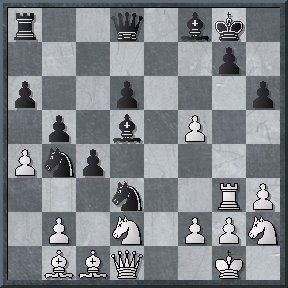
23.¤df1! This position was annotated by the Brazilian grandmaster Giovanni Vescovi (it could occur in his game). He analyzed the following a bit cooperative line: 23.¤g4 h5 24.¤h6+ ўh8 25.¤xc4 bxc4 26.Јxh5 Јe8 27.¤f7+ ўg8 with a draw by perpetual. Evgeny plays stronger.
23...¤xc1 24.Јxc1 ўh8 25.¤g4
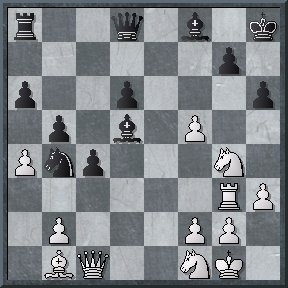
25...¤d3! This move devaluates Black`s pawn structure but his king feels more at ease now. Moreover Black gets two bishops against two knights and this is also a favourable argument for him.
26.Ґxd3 cxd3 27.Јf4 If 27.¦xd3 Ґe4 taking the f5 pawn.
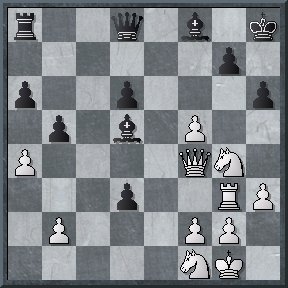
27...¦c8? In such a position the price of a mistake is very high so Black`s position becomes lost right off. There was an excellent resource at his disposal 27...Јe8! 28.f6!? (28.¦xd3 Јe4 29.Јg3 Јxf5 leads to a roughly equal play.) 28...Јe4 29.fxg7+ Ґxg7 30.Јxd6 ¦f8 with a very sharp and unclear play.
28.¦xd3 ¦c4 29.Јg3 Ґe4? Loses on the spot. More stubborn is 29...Ґg8 although here after 30.axb5 axb5 31.¤e5 ¦c1 32.Јe3 or even the simple 32.b3 White has a huge advantage.
30.¤e5 In contrast to the first tie-break game miracles didin`t happen and White converted his extra material easily.
30...Јf6 31.¤xc4 bxc4 32.¦d2 Ґxf5 33.Јf4 Ґe6 34.Јxf6 gxf6 35.¤e3 f5 36.¦c2 ўg7 37.¤xc4 ўf6 38.¤d2 d5 39.¦c6 a5 40.¤b3 ўe7 41.¤xa5 Ґd7 42.¦a6 Ґg7 43.b4 d4 44.¤c6+ ўe8 45.ўf1 d3 46.b5 Ґe6 47.¦a8+ Dmitry Jakovenko chose a very risky opening line and running into a problem which he hadn`t prepared at home couldn`t solve it with a little time on the clock. My congratulations to Evgeny Alekseev! 1-0
Summary
EvgenyAlekseev. Thehero of the tournament! He played betterthan all the others and for that reason won. I should say Evgeny`s potential is great and he can play even stronger than in this championship.
DmitryJakovenko. Together with Evgeny he played well but was a bit unlucky on tie-breaks.
Ernesto Inarkiev He showed a very interesting play and could have counted on a better result had he not suffered an annoying defeat in round 7.
Peter Svidler The tournament didn`t turn out right for Peter. Nevertheless being clearly in a bad form he scored "the obligatory" +2 giving the evidence of his high class.
Sergey Rublevsky The same can be said as about Peter but the resultis 50 percent. Notable is his nice victory over the future champion.
Ildar Khairullin The young player should play a more combative and aggressive chess if he wants to progress.
Evgeny Tomashevsky His performance was rather good. Sometimes he outplayed his opponents sometimes he was outplayed. His play was unstable and uneven. Time trouble was a serious embarrassment.
Segey Grigoriants A high class was revealed in some games but he lacks "go-ahead power" to show better results.
Ian Nepomniachtchi He is the one who impressed the most! Extremely creative, courageous and reckless play! Undoubtedly Ian`s disposition may allow him to reach the highest achievements.
Denis Khismatullin Denis is a bright and talented player but his play lacks reliability. Perhaps he ought to study the games of Peter Leko and to learn a couple of classical openings.
Nikita Vitiugov In some games especially with Black against Sergey Rublevsky and Peter Svidler he was quite good but on the whole the tournament was a failure. Why? I don`t know. But I know that Nikita is able to play better.
Evgeny Najer Evgeny is a very creative, strong and mature player. What happened to him is impossible to understand. I wish him to forget this misfortune as soon as possible and to show in the future the play he is capable of.
